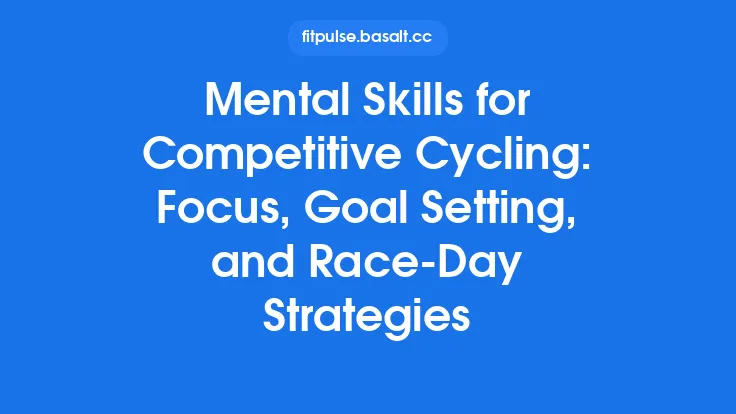When it comes to keeping a household active, the biggest hurdle is often not the lack of space or equipment, but the challenge of motivating family members of vastly different ages to engage consistently in physical activity. While a child might be thrilled by a sticker chart and a teenager may respond to social recognition, a senior might find meaning in tracking improvements in mobility or balance. The key lies in crafting reward systems and goal‑setting strategies that respect each generation’s developmental stage, personal values, and intrinsic motivations. Below is a comprehensive guide that walks you through the psychology, practical tools, and step‑by‑step processes needed to build a motivating framework that works for everyone under one roof.
Understanding Motivation Across Generations
Developmental drivers
- Early childhood (3‑10 years): Children at this stage are highly responsive to immediate, tangible rewards and visual progress cues. Their sense of competence is nurtured by clear, bite‑sized challenges that can be completed quickly.
- Adolescence (11‑18 years): Peer validation, autonomy, and identity formation become central. Rewards that reinforce personal achievement and allow for self‑expression (e.g., digital badges, leaderboards) are especially effective.
- Young adulthood (19‑35 years): This group often balances work, education, and social life. Goal‑oriented incentives tied to long‑term health benefits, time‑saving outcomes, or lifestyle integration (e.g., “Earn a weekend hike after 10 workouts”) resonate well.
- Middle adulthood (36‑55 years): Responsibilities such as career advancement and family care dominate. Rewards that acknowledge consistency, stress reduction, or family cohesion (e.g., “Family movie night after a month of joint sessions”) are powerful motivators.
- Older adulthood (56+ years): Maintaining independence, functional ability, and social connection are top priorities. Non‑material rewards like tracking improvements in balance, flexibility, or daily energy levels, and celebrating milestones with family recognition, tend to be most meaningful.
Intrinsic vs. extrinsic motivation
- Intrinsic motivation stems from personal enjoyment, mastery, or the inherent satisfaction of movement. It is the most durable driver but can be fragile if not nurtured.
- Extrinsic motivation involves external rewards—tangible or social. While useful for initiating behavior, it should be carefully balanced to avoid undermining intrinsic interest.
A successful family system blends both: start with extrinsic cues to spark participation, then gradually shift focus toward intrinsic satisfaction as competence and confidence grow.
Principles of Effective Goal Setting for Families
- SMART goals adapted for each age group
- Specific: Clearly define the activity (e.g., “Complete a 5‑minute balance routine”).
- Measurable: Use quantifiable metrics (reps, time, distance).
- Achievable: Align difficulty with the individual’s current ability.
- Relevant: Connect the goal to personal values (e.g., “Improve stamina for school sports”).
- Time‑bound: Set realistic deadlines (daily, weekly, monthly).
- Tiered goal hierarchy
- Micro‑goals: Daily or per‑session targets that provide quick wins.
- Meso‑goals: Weekly or bi‑weekly objectives that build on micro‑goals.
- Macro‑goals: Long‑term aspirations (3‑6 months) that give the family a shared vision.
- Collaborative goal creation
- Involve each family member in the brainstorming process. This fosters ownership and ensures goals are personally meaningful.
- Use a “family council” meeting (once a month) to review progress, adjust targets, and celebrate achievements.
- Positive framing
- Phrase goals in terms of what will be gained rather than what will be avoided (e.g., “Gain 10 extra minutes of active play” vs. “Avoid sitting for more than 2 hours”).
Designing Age‑Appropriate Reward Systems
| Age Group | Reward Type | Implementation Tips |
|---|---|---|
| Preschool‑to‑Early School (3‑10) | Tangible tokens (stickers, small toys) | Use a visual chart at eye level. Each completed session earns a sticker; a row of stickers unlocks a larger reward (e.g., a new storybook). |
| Pre‑Teens & Teens (11‑18) | Social recognition (digital badges, family shout‑outs) | Create a shared online board where achievements are posted. Encourage peers to comment and “like” each other’s progress. |
| Young Adults (19‑35) | Experiential rewards (movie night, weekend outing) | Set a points system: each workout earns points; accumulating a set number triggers a family outing or personal treat. |
| Middle‑Age Adults (36‑55) | Functional incentives (extra leisure time, household pass) | Offer “skip‑the‑chores” coupons that can be redeemed after a streak of workouts. |
| Seniors (56+) | Non‑material acknowledgments (family praise, progress certificates) | Celebrate improvements in balance or endurance with a “Milestone Certificate” displayed in a common area. |
Key design considerations
- Immediate vs. delayed rewards: Younger children need immediate reinforcement; older members can handle delayed gratification. Structure the system accordingly.
- Variety: Rotate reward types to prevent habituation.
- Equity: Ensure that rewards are perceived as fair across ages. For instance, a senior’s “extra 15 minutes of reading time” can be as valued as a teen’s “new video game credit.”
- Avoid over‑reliance on material incentives: Use them sparingly to keep the focus on health benefits and personal growth.
Implementing a Family Goal‑Tracking Framework
- Choose a central tracking medium
- Physical board: A magnetic board in the kitchen with individual columns for each family member.
- Digital app: A shared spreadsheet or a family‑focused habit‑tracking app that syncs across devices.
- Define tracking metrics
- Quantitative: Number of sessions, minutes exercised, repetitions.
- Qualitative: Self‑rated enjoyment (1‑5 scale), perceived effort, mood after the session.
- Set review cadence
- Daily quick check: Mark completed activities.
- Weekly summary: Review totals, discuss any barriers, and award micro‑rewards.
- Monthly deep dive: Analyze trends, adjust goals, and celebrate macro‑achievements.
- Integrate feedback loops
- Encourage each member to voice what they liked or disliked about the week’s workouts.
- Use this feedback to tweak goal difficulty, reward types, or session timing.
- Visual progress cues
- Use color‑coded stickers or icons to indicate different intensity levels or types of activity.
- For digital tools, employ graphs that show upward trends, reinforcing a sense of mastery.
Leveraging Technology to Enhance Motivation
- Gamified platforms: Apps that turn workouts into quests (e.g., “collect 100 steps to unlock a virtual treasure”). Choose platforms that allow family accounts and customizable avatars.
- Wearable data sharing: Smartwatches can broadcast daily step counts to a family group chat, fostering friendly competition without pressuring any single member.
- Automated reminders: Calendar alerts or voice‑assistant prompts can cue workout times, especially helpful for busy adults and seniors who may forget scheduled sessions.
- Virtual badges and certificates: Generate printable PDFs that celebrate milestones; these can be displayed on a fridge or a home office wall.
When selecting tech tools, prioritize simplicity and privacy. The goal is to augment motivation, not to create a barrier for less tech‑savvy members.
Balancing Intrinsic and Extrinsic Motivation
- Start with extrinsic cues to get the ball rolling—especially for younger children who need clear, immediate reinforcement.
- Gradually introduce intrinsic elements:
- Reflection prompts after each session (“What did you enjoy most?”).
- Skill mastery tracking (e.g., “I can now hold a plank for 30 seconds”).
- Purpose alignment (linking activity to personal aspirations like “running faster in soccer” or “maintaining independence”).
- Phase‑out overused extrinsic rewards once a habit is established. Replace them with verbal praise, autonomy (letting the individual choose the next activity), and opportunities for self‑evaluation.
Common Pitfalls and How to Avoid Them
| Pitfall | Why It Happens | Prevention Strategy |
|---|---|---|
| One‑size‑fits‑all rewards | Assumes all ages value the same incentives. | Conduct a brief “reward preference” survey with each family member. |
| Over‑emphasis on competition | Can demotivate less athletic members. | Emphasize personal bests and collaborative challenges (e.g., “total family minutes”). |
| Reward fatigue | Repeating the same reward loses novelty. | Rotate reward categories every 4‑6 weeks. |
| Neglecting progress visibility | Without visible tracking, effort feels invisible. | Keep the tracking board in a high‑traffic area; update it together. |
| Setting unrealistic goals | Leads to frustration and dropout. | Use the SMART framework and regularly reassess difficulty. |
| Ignoring intrinsic signals | Over‑reliance on external rewards can suppress internal drive. | Incorporate reflection questions and celebrate non‑tangible achievements. |
Case Studies: Real‑World Applications
Case 1 – The Martinez Family (2 adults, 2 kids, 1 grandparent)
- Goal hierarchy: Kids aimed for “10‑minute daily play,” adults for “150 minutes of moderate activity per week,” grandparent for “improve balance to walk unaided for 20 minutes.”
- Reward system: Kids earned stickers; a full row unlocked a family pizza night. Adults earned “skip‑a‑chore” coupons; grandparents received a weekly “Family Appreciation” note.
- Outcome: After 3 months, the family reported a 40 % increase in joint activity time, and the grandparent noted measurable improvements in balance tests.
Case 2 – The Lee Household (single parent, teenage son, toddler)
- Technology use: Adopted a shared habit‑tracking app with customizable avatars. Each completed workout added “energy points” to the avatar’s stamina bar.
- Reward shift: Initially, the teen earned a digital badge for each streak; after 4 weeks, the parent introduced a “choose‑your‑activity” privilege, letting the teen pick a weekend outing.
- Result: The teen’s intrinsic motivation grew, evidenced by self‑initiated workouts on days without external prompts.
Case 3 – The Patel Seniors (two retirees, adult daughter visiting weekly)
- Focus on non‑material rewards: Created a “Milestone Wall” where each improvement in walking distance was marked with a decorative pin.
- Goal setting: Set a macro‑goal of “walk 5 km without rest by summer.”
- Result: The seniors reported higher confidence in daily mobility, and the daughter noted increased willingness to join them for short walks.
Putting It All Together: A Step‑by‑Step Guide
- Gather the family for a 30‑minute brainstorming session.
- Identify personal motivations for each member (write them down).
- Draft SMART goals that align with those motivations, categorizing them into micro, meso, and macro levels.
- Select a tracking method (board or app) and set up individual columns or profiles.
- Design a reward matrix tailored to each age group, ensuring a mix of tangible, experiential, and non‑material incentives.
- Implement a pilot week: start with simple micro‑goals and immediate rewards.
- Hold a brief daily check‑in to mark progress and provide quick praise.
- Conduct a weekly family review: tally points, award micro‑rewards, discuss any obstacles.
- Introduce intrinsic reflection: ask “What did you enjoy?” and “What did you learn?” after each session.
- Adjust goals and rewards based on feedback and observed engagement levels.
- Celebrate macro‑achievements with a family event that honors the collective effort (e.g., a picnic, a photo collage of the journey).
- Repeat the cycle, gradually shifting emphasis from extrinsic to intrinsic motivators as habits solidify.
By following this structured yet flexible approach, families can create a motivating environment where every generation feels valued, challenged, and celebrated. The result is not just a healthier household, but a stronger bond forged through shared purpose and mutual encouragement.




